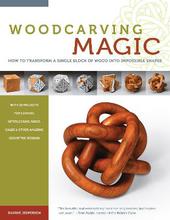
|
Woodcarving Magic: How to Transform A Single Block of Wood Into Impossible Shapes
Paperback / softback
Main Details
| Title |
Woodcarving Magic: How to Transform A Single Block of Wood Into Impossible Shapes
|
| Authors and Contributors |
By (author) Bjarne Jespersen
|
| Physical Properties |
| Format:Paperback / softback | | Pages:128 | | Dimensions(mm): Height 279,Width 216 |
|
| Category/Genre | Carving and modelling, moulding and casting
Carpentry and woodworking - general |
|---|
| ISBN/Barcode |
9781565235236
|
| Classifications | Dewey:736.4 |
|---|
| Audience | |
|---|
|
Publishing Details |
| Publisher |
Fox Chapel Publishing
|
| Imprint |
Fox Chapel Publishing
|
| Publication Date |
28 August 2020 |
| Publication Country |
United States
|
Description
If you thought carving a linked chain or a ball-in-cage was a challenge, get ready for some mind-altering woodcarving projects! Learn how to uncover the structure of space by looking inside a piece of wood and carving away anything that doesn't match your vision.
Author Biography
Bjarne Jespersen is an internationally-known woodcarver and sculptor with a passion for mathematics and geometry. He uses creative geometry to give new life to "magic woodcarving" - carving a piece of wood into sections that are loose but cannot be separated.
Reviewshttp: //www.shortcuts.ns.ca/column/column743/ There is a Danish gentleman that can see more into a small block of wood than anyone that I know of. Even Ernoe Rubik is in awe of his work. His name is Bjarne Jespersen and his carvings are amazing. The sub-title of this amazing book is "HOW TO TRANSFORM A SINGLE BLOCK OF WOOD INTO IMPOSSIBLE SHAPES." And judging from the contents the author has seemingly done the impossible. The first 55 pages are very important as Jespersen details his methods and tools. He then goes on to detail the 29 "impossible" shapes. There is the Hopf Link, the Lovers' Hearts and the Borromean Rings just for starters. Then, things start to get a little more complex but the author takes the carving to the nth degree. He carves a (are you ready for this?) Rhombicosidodecahedron and shows us how. And, it all starts with a wooden cube. Wow! One of this reviewer's earliest memories is of two wood carvings that sat on a cabinet in grandma's bedroom. Shaped like little towers, they had wooden balls held captive inside cavities along their length. Everyone marvelled at them, trying to see a crack, a mark, anything that would prove that the balls were introduced to their cages, for surely, surely, they could not have been carved there. How much more would they have marvelled, had they been able to see the work of Bjarne Jespersen. Where those old carvings might have seemed unlikely, the convoluted shapes of Jespersen's carvings seem absolutely incredible. The piece shown on the cover of his book is representative of the projects for which Jespersen gives instruction, but it is by no means the most complicated. Despite the title of the book, there is nothing magical about the work, though it seems so, for all these wondrous pieces are carved from a single block of wood. Early in the book, there are clues as to how these remarkable pieces were developed, The author confesses to an adolescent interest in solid geometry and a life long interest in what he terms 'recreational mathematics'. These are unquestionably important attributes for anyone wishing to design something like the Inverted Great Tetraknot. Fortunately, the same background is not required of the reader. At the beginning of Chapter 4, the author writes: 'Plenty of the projects in this book can be carved by following the drawings and instructions.' One might imagine that this will be enough for many readers, but Jespersen appears keen to recruit others to his level of the discipline, providing guidance in building mock-ups and prototypes for use in the development of new projects. The author carefully explains his tools and methods, discusses the preparation of a blank a'nd drawing the necessary lines to guide the carving. If you don't know what a Cubotetrahedron or a Dodecahedron is, it doesn't matter, since the diagrams and descriptions are quite explicit. The chapter on Getting Started begins very simply with the carving of a couple of rings. Despite the simplicity of the techniques learned here, they can be put to immediate use making a charming alternative - entwined Lover's Hearts. The natural progression from these exercises is the carving of a chain and from there, to the carvi ng of flat ri ngs, By Chapter 8, the discussion has turned to Cages and it no longer seems so very far to the intricate, intertwined rings that earn titles such Hosohedral Hexalink. Despite the long names and the strong mathematical basis for the pieces, this is a practical book aimed at helping students to do their own woodcarving magic. Woodcarving Magic by Bjarne Jespersen is subtitled "How to Transform a Single Block of Wood Into Impossible Shapes" and includes instructions pocket-sized "gizmos" such as puzzles, cages, spheres, chain-links and more -- with geometric explanations of how they work.
|